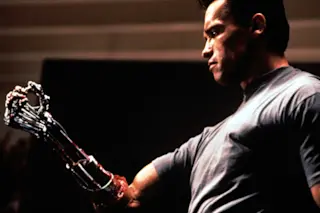Sci-fi movies have shown us what it might be like to shrink down to the size of an ant, or to blow a grasshopper up to the size of a skyscraper. And while a shrink ray may never be a scientific reality, a team led by MIT’s Edward Boyden has actually found a way to expand biological tissue to several times its original size – giving researchers a more detailed look than ever at microscopic structures within the body. And as silly as it sounds, the substance they’ve used for this upsizing is the same polymer that makes baby diapers swell up when they get wet.
A Joking Beginning
The idea for this approach started with an offhand remark. “We had gotten frustrated with existing methods of imaging tiny objects,” Boyden recalls, “and we half-jokingly started talking about just making everything bigger.”
Before long, some of the team members started digging up research papers on swellable polymers and decided to give these techniques a try on biological tissue. The team started with a material known as polyelectrolyte gel, which is known for its ability to expand in water – a property that’s familiar to anyone who’s ever had to change a wet diaper.
What no one had ever tested, though, was whether this gel could be injected into biological tissue and cause that to expand, too. After injecting the gel into some chemically treated samples of brain tissue, the researchers triggered the material to expand by adding water – which it did, smoothly, to 4.5 times its original size.
“If a light microscope could see things that 300 nanometers across before,” Boyden explains, “it now can see things that are just 70 nanometers across,” thanks to the expansion.
As they refined this expansion technique, the researchers developed a labeling and treatment process that allowed them to accurately label and map the expanded tissue. They gave this overall process – labeling, injection, and expansion – the name “expansion microscopy.”
Accurate Expansion
To determine just how accurate their new technique of expansion microscopy was, the team scanned some unprocessed tissue samples with a confocal laser scanning microscope - a powerful magnification tool that enables researchers to focus on selected depths of objects just a few microns (thousandths of a millimeter) across.
Then they performed their expansion process on the samples and scanned them again. Despite the tissue’s 4.5-fold increase in size, the researchers calculated that its shape had changed by less than one percent. This meant their expansion process was effectively identical to a 4.5-fold magnification increase.
“By mathematically comparing the pre-expansion vs.post-expansion image,” Boyden says, “we could prove that the distortion was minimal.” The results appear in this month’s issue of the journal Science.
Brainy Applications
Now that the team was certain of their technique’s precision, they put it to use on brain tissue. Since their expansion process enabled them to “zoom in” on microscopic structures more closely than ever before, they were able to capture detailed images of synaptic connections between brain cells. The resolution of these images is so high that it’s possible to see individual protein molecules flying from one neuron to the next.
For the immediate future, Boyden and his team hope to increase the expansion factor even more, for greater magnification. They also want to integrate other analysis techniques - including the latest methods for identifying mRNAs, DNA, proteins, and other biomolecules - into their expansion microscopy process, so we can get a closer look than ever at the chemicals that make up our bodies.
This could be good news for patients who suffer from neurodegenerative disorders like Alzheimer’s, since it’ll enable doctors to delve into the details of neural decay. Techniques like this may also help researchers develop more targeted medicines, and gain helpful new insights into the exact mechanisms by which existing treatments impact bodily function. With a little luck, that means our range of precision therapies may undergo its own expansion.














